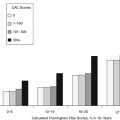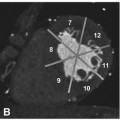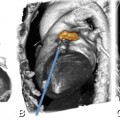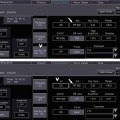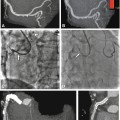Fig. 5.1
The patient population with suspected CAD that is clinically most suitable for undergoing coronary CT angiography is highlighted in blue and has a pretest likelihood of disease of 20–70%. CT coronary angiography is very accurate in ruling out disease over a wide range of clinical presentations, as can be seen in the very low posttest likelihood after a negative CT (below 10% for pretest likelihoods of up to 70%). Thus, coronary CT angiography allows reliable exclusion of disease. However, patients with a likelihood of less than 20% may not benefit from noninvasive testing because of the very low positive predictive value in this group, which may lead to a rather high rate of unnecessary conventional coronary angiographies. This calculation, made according to the Bayes’ theorem, is based on the overall sensitivity and specificity of coronary CT angiography in patients with suspected CAD, as specified in Chap. 25 and modified from Schuetz et al. Ann Intern Med 2010
Thus, the preferred patient population for CT coronary angiography has a pretest likelihood of CAD of 20–70%. In Tables 5.1, 5.2, and 5.3, patients with a pretest likelihood in this range are highlighted in blue. The markings in the tables make it easy to identify those patients who are most likely to benefit from coronary CT angiography and to simultaneously exclude others who should not undergo this test. These tables may also be helpful in increasing the cost-effectiveness of coronary CT angiography, as costly and unnecessary secondary examinations, which are more likely in very low (<20%) and high-likelihood patients (>70%), can potentially increase societal costs related to the diagnosis of CAD.
Table 5.1
Likelihood (in %) of CAD according to sex, age, and symptomsa
Men | Women | ||||||
|---|---|---|---|---|---|---|---|
Age (years) | Nonanginal chest painb | Atypical anginac | Typical anginad | Age (years) | Nonanginal chest painb | Atypical anginac | Typical anginad |
30–39 | 0.8 | 4 | 26 | 30–39 | 5 | 22 | 70 |
40–49 | 3 | 13 | 55 | 40–49 | 14 | 46 | 87 |
50–59 | 8 | 32 | 79 | 50–59 | 22 | 59 | 92 |
60–69 | 19 | 54 | 91 | 60–69 | 28 | 67 | 94 |
Table 5.2
Posttest likelihood (in %) of CAD in women after an electrocardiographic stress test (ST depression), according to age and symptomsa
Women | |||||
|---|---|---|---|---|---|
ST depression (mm) | Age (years) | Asymptomatic | Nonanginal chest painb | Atypical anginac | Typical anginad |
0–0.5 | 30–39 | 0.1 | 0.2 | 1 | 7 |
40–49 | 0.2 | 0.7 | 3 | 22 | |
50–59 | 0.8 | 2 | 10 | 47 | |
60–69 | 2 | 5 | 21 | 69 | |
0.5–1.0 | 30–39 | 0.3 | 0.7 | 4 | 24 |
40–49 | 0.9 | 3 | 12 | 53 | |
50–59 | 3 | 8 | 31 | 78 | |
60–69 | 7 | 17 | 52 | 90 | |
1.0–1.5 | 30–39 | 0.6 | 2 | 9 | 42 |
40–49 | 2 | 6 | 25 | 72 | |
50–59 | 7 | 16 | 50 | 89 | |
60–69 | 15 | 33 | 72 | 95 | |
1.5–2.0 | 30–39 | 1 | 3 | 16 | 59 |
40–49 | 4 | 11 | 39 | 84 | |
50–59 | 12 | 28 | 67 | 94 | |
60–69 | 25 | 49 | 83 | 98 | |
2–2.5 | 30–39 | 3 | 8 | 33 | 79 |
40–49 | 10 | 24 | 63 | 93 | |
50–59 | 27 | 50 | 84 | 98 | |
60–69 | 47 | 72 | 93 | 99.1 | |
>2.5 | 30–39 | 11 | 24 | 63 | 93 |
40–49 | 28 | 53 | 86 | 98 | |
50–59 | 56 | 78 | 95 | 99.3 | |
60–69 | 76 | 90 | 98 | 99.7 | |
Table 5.3
Posttest likelihood (in %) of CAD in men after an electrocardiographic stress test (ST depression), according to age and symptomsa
Men | |||||
|---|---|---|---|---|---|
ST depression (mm) | Age (years) | Asymptomatic | Nonanginal chest painb | Atypical anginac | Typical anginad |
0–0.5 | 30–39 | 0.4 | 1 | 6 | 25 |
40–49 | 1 | 4 | 16 | 61 | |
50–59 | 2 | 6 | 25 | 73 | |
60–69 | 3 | 8 | 32 | 79 | |
0.5–1.0 | 30–39 | 2 | 5 | 21 | 68 |
40–49 | 5 | 13 | 44 | 86 | |
50–59 | 9 | 20 | 57 | 91 | |
60–69 | 11 | 26 | 65 | 94 | |
1.0–1.5 | 30–39 | 4 | 1 | 38 | 83 |
40–49 | 11 | 26 | 64 | 94 | |
50–59 | 19 | 37 | 75 | 96 | |
60–69 | 23 | 45 | 81 | 97 | |
1.5–2.0 | 30–39 | 8 | 19 | 55 | 91 |
40–49 | 20 | 41 | 78 | 97 | |
50–59 | 31 | 53 | 86 | 98 | |
60–69 | 37 | 62 | 90 | 99 | |
2.0–2.5 | 30–39 | 18 | 38 | 76 | 96 |
40–49 | 39 | 65 | 91 | 99 | |
50–59 | 54 | 75 | 94 | 99.2 | |
60–69 | 61 | 81 | 96 | 99.5 | |
